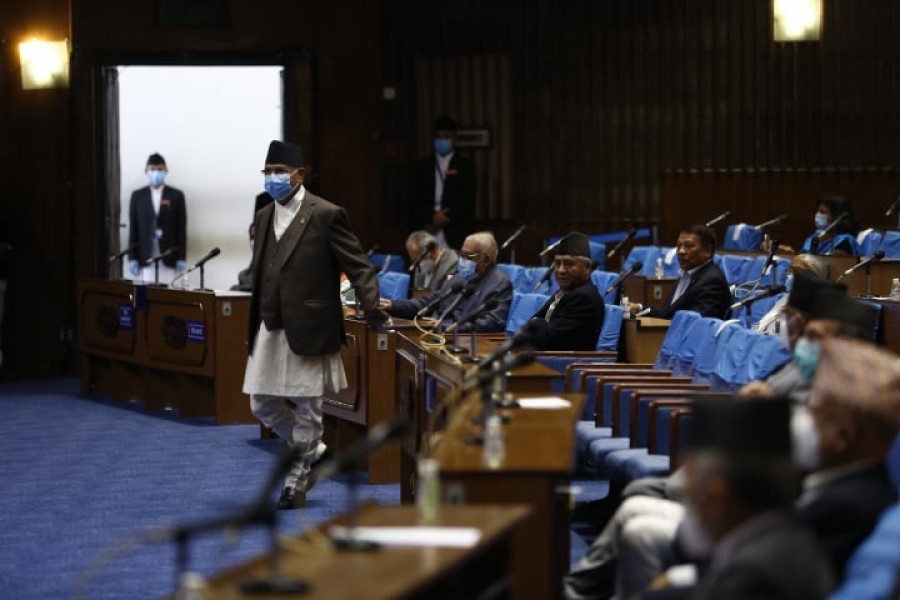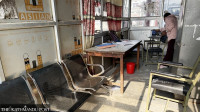National
What’s Article 76 on which the House will focus now onwards
The provision on government formation will come into play as Oli will try to remain in power while others to unseat him.
Binod Ghimire
When the Oli government’s decision to dissolve the House of Representatives was being heard by the Constitutional Bench of the Supreme Court between December 23 and February 19, the major arguments were whether a majority prime minister could do so or not. One of the constitutional provisions that was widely debated–not only at the courtrooms but also at tea shops to newsrooms–was Article 76 and its sub-clauses.
Prime Minister Oli himself had cited Articles 76 (1) and 76 (7) to defend his House dissolution move.
The Constitutional Bench, however, on February 23 overturned his decision and reinstated the House. The first meeting of the reinstated House was held on Sunday. But earlier that day, the Supreme Court passed yet another verdict, scrapping the Nepal Communist Party (NCP), with NCP within brackets, and revived the CPN-UML and the Communist Party of Nepal (Maoist Centre), thereby changing the country’s entire political landscape.
Even though his House dissolution move was overturned by the court, Oli has not resigned despite many saying he should have on moral grounds.
As per Sunday’s court order, the Election Commission on Tuesday scrapped the Nepal Communist Party (NCP) and recognised the old constituents UML and the Maoist Centre led by Oli and Dahal as parties registered with it. On Monday, leaders including Madhav Kumar Nepal and Jhala Nath Khanal and around 38 other lawmakers who were with Dahal decided to return to the UML.
On Sunday, the Oli group of then Nepal Communist Party (NCP) had decided to seek a vote of confidence if the Maoist Centre withdrew its support.
The meeting was held hours after the Supreme Court revived the UML and the Maoist Centre.
Though the Maoist Centre on Tuesday held a meeting of its Standing Committee, it could not decide whether to withdraw its support to Oli. It, however, has decided to consult with Nepali Congress, the primary opposition, and Janata Samajbadi Party.
But what will happen and how will the House proceedings move ahead if the Maoist Centre withdraws support to Oli?
It will all be about the number game and Article 76 is going to come into play, whose clauses are related to government formation.
Oli will have to seek a vote of confidence within 30 days from the day the Maoist Centre withdraws its support, according to constitutional experts.
As per Article 100 (2) of the Constitution of Nepal, if the political party which the prime minister represents is divided or a political party in coalition government withdraws its support, the prime minister shall table a motion in the House of Representatives for a vote of confidence within 30 days.
When Oli was elected prime minister in February 2018, he was the leader of the UML and the Maoist Centre had extended support. The two parties later merged in May 2018.
As Oli’s government, after the Supreme Court’s verdict to revive the UML and Maoist Centre, stands as per Article 76 (2), Oli will have to seek and win the confidence of the House to remain in power as per Article 76 (3).
Article 76 (2) says in cases where no party has a clear majority in the House, the President shall appoint as the prime minister “a member of the House who can command a majority with the support of two or more parties.”
Oli’s UML had won 121 seats in the 2017 elections and the Maoist Centre 53. In the 275-member House, Oli’s party was short of 17 seats. But the Maoist Centre’s support meant he had a nearly two-thirds majority government. That was the reason, advocates pleading against his House dissolution move argued that the constitution does not provide any grounds to a majority prime minister to do so.
As per Article 76 (3), the President is allowed to appoint the parliamentary party leader of the largest party, as the prime minister, who then has to seek a vote of confidence within 30 days.
With 120 lawmakers in the 275-member House, the UML is the largest party and Oli is its Parliamentary Party leader.
“Oli will have to resign if he fails to win a vote of confidence,” senior advocate Bhimarjun Acharya, who specialises on constitutional law, told the Post. “That will open the door for the formation of a government as per Article 76 (5).”
Winning the House confidence will make him prime minister but the constitution does not bar any party with required numbers (one-fourth of the lawmakers) from filing a no-confidence motion against him, according to Acharya.
But even before the government formation process begins as per Article 76 (3), Oli still has a possibility to continue as a prime minister of a coalition as per Article 76 (2), provided that he manages to clinch the support of both the Congress party and Janata Samajbadi Party or either of them.
There are currently 270 members in the House, a UML seat is vacant following the death of its occupant while two Congress and as many Janata Samajbadi Party parliamentarians remain suspended. Oli will, hence, need the support of 135 lawmakers. His UML party needs the support of 15 lawmakers. The Nepali Congress has 61 members and Janata Samajbadi Party has 32 members in Parliament.
If the Nepali Congress supports Oli, he could again lead a two-thirds majority government.
“It is up to the Congress and Janata Samajbadi Party to determine whether Oli can continue a coalition government as per Article 76 (2),” senior advocate Purna Man Shakya, who also specialises on constitutional law, told the Post.
Complications will arise if neither the Congress nor Janata Samajbadi Party extends support to Oli when he seeks a vote of confidence after the Maoist Centre withdraws its support.
Article 76 (5) then will be invoked, according to experts.
As per Article 76 (5), any member of the House who presents a ground on which she/he can garner a vote of confidence in the House gets appointed as a prime minister.
Acharya says anyone making a claim under the Article must ensure she/he has support from a majority of lawmakers. According to him, there is actually not much difference in the process to form the government as per Article 76 (2) and 76 (5).
“The only difference is the former talks about the party while the latter talks about an individual,” said Acharya. “This is an oversight from the drafters. Indirectly, Article 76 (5) too also produces a coalition government.”
The prime minister elected under this article too has to pass a vote of confidence within 30 days from the date of appointment.
Article 76 (5) is the last of the provisions provided by the constitution for government formation.
If a prime minister cannot be appointed or a prime minister appointed under this article fails to obtain a vote of confidence within 30 days, the House, according to Article 76 (7), is dissolved and elections are declared so that a new House of Representatives can be elected within six months.
Article 76 (7) comes into play only when all the options for government formation are exhausted. That’s why, according to experts, Oli was wrong to cite the article to dissolve the House.
Analysts say politics has evolved at such a rapid pace over the last few days and with the new equations and various combinations emerging after the Supreme Court decision to scrap the Nepal Communist Party (NCP), midterm elections cannot be ruled out.
“If Oli fails to win the confidence of the House and parties exhaust all options to form a new government, Parliament will have to be dissolved and elections will be declared,” said Mohan Lal Acharya, an advocate and former adviser to the Constituent Assembly. “This dissolution, however, will be different from the one that Oli had attempted. Such a dissolution, if it happens, will be legal and constitutional, but Oli’s December 20 move was out and out unconstitutional, and the court too said so.”




 17.12°C Kathmandu
17.12°C Kathmandu















